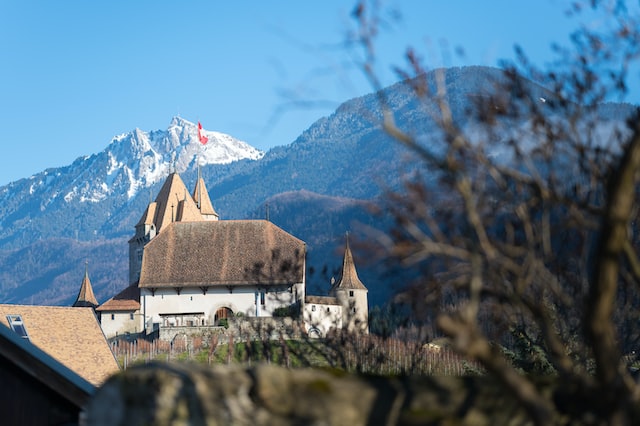8 of the best Easter events in Switzerland you won't want to miss

From fun fares to egg hunts and Swiss traditions, here are some events you shouldn’t miss this Easter in Switzerland.
Osterchilbi
If you happen to live or be visiting the Zurich area over the Easter break and are looking for something quintessentially Swiss to do, drop by the Osterchilbi held at the Klotener Stadtplatz from April 8th-16th 2023 between 1.30pm and 10pm.
Swiss chilbis, or annual fairs, are a must-see at least once in your lifetime and feature many rides, claw machines, games, and delicious local and foreign foods for you to try.
Easter egg hunt
For those with children, Baden’s Easter egg hunt is well worth a visit. The traditional egg hunt is hosted in the large park around the Museum Langmatt and includes many great hiding places for 200 children aged 8 and under to enjoy.
The hunt starts at 3pm on April 8th and will take place in all weather conditions, just remember to bring your own baskets.

Get ready for Easter events in Switzerland. Photo: George Dolgikh @ Giftpundits.com / Pexels
Zwänzgerle
Always fancied taking part in a Swiss tradition? Now’s your time to shine and win some money – if you’re any good that is. Zwänzgerle is an Easter tradition dating back to the 18th century that is still celebrated in the city of Zurich each year.
Every Easter Monday morning, crowds of adults and children gather in the heart of Zurich’s Old Town to play a few rounds of Zwänzgerle. The tradition dictates that children hold out a hard-boiled egg while adults throw 20-cent coins aimed at cracking the egg. Only if the coin lodges in the shell does the adult win, making Zwänzgerle a blast for children.
Blaueierschwimmen
This unique Easter tradition takes place in in the Seebadi Niederuster at 2pm on April 10th. To get hold of a blue egg, hundreds of participants must venture into the 5-13C cold Greifensee lake and retrieve the egg some 20 metres away.
Whether you're visiting as a pro swimmer or prefer to enjoy a snack as a bystander, this event is good fun for the whole family.
Easter at Aigle castle
Another fabulous Easter activity for children will take place at the Aigle castle, itself a Swiss heritage site of national significance.
Every Wednesday to Saturday in April between the hours of 2pm and 3.30pm and 4pm and 5.30pm visitors can delight in the castle’s mesmerising surroundings during springtime. The castle will also be organising various activities for children, such as hide-and-seek with an Easter bunny, a treasure hunt and Easter-related storytelling.

Chemin du Château, Aigle, Switzerland. Photo by Yann Lerjen on Unsplash
Easter market
If you’re looking to combine a leisurely stroll with magnificent views over Lake Zug with a shopping trip and delicious food, look no further than the town’s Easter market.
The market, which takes place on April 10th from 9am to 6pm, will feature some 60 vendors offering a wide variety of items, from jewellery and leather goods, to toys, accessories, and home-made bread. If you get hungry, you can choose from a number of food stalls serving tasty and healthy dishes for young and old.
Easter at the rural and craft museum
If your kids have had their fair share of egg-hunting this Easter, why not have them hunt for chicks instead?
Between April 7th-23rd, the Musée paysan & artisanal in La Chaux-de-Fonds will be home to a set of hens and their chicks. Children are invited to come observe the animals and learn about the many objects in the museum by locating the hidden chicks.
Easter at the Vullierens castle
On Easter Sunday, April 9th from 9.30am to 6pm, visitors can participate in the great Easter egg and treasure hunt in the gardens of the Vullierens castle. Children can follow in the footsteps of Lindt’s gold rabbit in the search for lost eggs. The good news? The game is adapted for different age brackets, with older children being given more challenging tasks involving planning and problem-solving.
The day will also include pony rides for the young, while adults can sip on delicious local wine.
Comments
See Also
Osterchilbi
If you happen to live or be visiting the Zurich area over the Easter break and are looking for something quintessentially Swiss to do, drop by the Osterchilbi held at the Klotener Stadtplatz from April 8th-16th 2023 between 1.30pm and 10pm.
Swiss chilbis, or annual fairs, are a must-see at least once in your lifetime and feature many rides, claw machines, games, and delicious local and foreign foods for you to try.
Easter egg hunt
For those with children, Baden’s Easter egg hunt is well worth a visit. The traditional egg hunt is hosted in the large park around the Museum Langmatt and includes many great hiding places for 200 children aged 8 and under to enjoy.
The hunt starts at 3pm on April 8th and will take place in all weather conditions, just remember to bring your own baskets.

Zwänzgerle
Always fancied taking part in a Swiss tradition? Now’s your time to shine and win some money – if you’re any good that is. Zwänzgerle is an Easter tradition dating back to the 18th century that is still celebrated in the city of Zurich each year.
Every Easter Monday morning, crowds of adults and children gather in the heart of Zurich’s Old Town to play a few rounds of Zwänzgerle. The tradition dictates that children hold out a hard-boiled egg while adults throw 20-cent coins aimed at cracking the egg. Only if the coin lodges in the shell does the adult win, making Zwänzgerle a blast for children.
Blaueierschwimmen
This unique Easter tradition takes place in in the Seebadi Niederuster at 2pm on April 10th. To get hold of a blue egg, hundreds of participants must venture into the 5-13C cold Greifensee lake and retrieve the egg some 20 metres away.
Whether you're visiting as a pro swimmer or prefer to enjoy a snack as a bystander, this event is good fun for the whole family.
Easter at Aigle castle
Another fabulous Easter activity for children will take place at the Aigle castle, itself a Swiss heritage site of national significance.
Every Wednesday to Saturday in April between the hours of 2pm and 3.30pm and 4pm and 5.30pm visitors can delight in the castle’s mesmerising surroundings during springtime. The castle will also be organising various activities for children, such as hide-and-seek with an Easter bunny, a treasure hunt and Easter-related storytelling.

Easter market
If you’re looking to combine a leisurely stroll with magnificent views over Lake Zug with a shopping trip and delicious food, look no further than the town’s Easter market.
The market, which takes place on April 10th from 9am to 6pm, will feature some 60 vendors offering a wide variety of items, from jewellery and leather goods, to toys, accessories, and home-made bread. If you get hungry, you can choose from a number of food stalls serving tasty and healthy dishes for young and old.
Easter at the rural and craft museum
If your kids have had their fair share of egg-hunting this Easter, why not have them hunt for chicks instead?
Between April 7th-23rd, the Musée paysan & artisanal in La Chaux-de-Fonds will be home to a set of hens and their chicks. Children are invited to come observe the animals and learn about the many objects in the museum by locating the hidden chicks.
Easter at the Vullierens castle
On Easter Sunday, April 9th from 9.30am to 6pm, visitors can participate in the great Easter egg and treasure hunt in the gardens of the Vullierens castle. Children can follow in the footsteps of Lindt’s gold rabbit in the search for lost eggs. The good news? The game is adapted for different age brackets, with older children being given more challenging tasks involving planning and problem-solving.
The day will also include pony rides for the young, while adults can sip on delicious local wine.
Join the conversation in our comments section below. Share your own views and experience and if you have a question or suggestion for our journalists then email us at [email protected].
Please keep comments civil, constructive and on topic – and make sure to read our terms of use before getting involved.
Please log in here to leave a comment.